What Does On A Camera Mean


A camera is an optical musical instrument that captures a visual paradigm. At a basic level, cameras consist of sealed boxes (the camera body), with a small hole (the aperture) that allows lite through to capture an image on a light-sensitive surface (unremarkably a digital sensor or photographic film). Cameras have diverse mechanisms to control how the light falls onto the light-sensitive surface. Lenses focus the light entering the camera. The aperture tin be narrowed or widened. A shutter machinery determines the corporeality of time the photosensitive surface is exposed to low-cal.
The nonetheless image camera is the main instrument in the art of photography. Captured images may be reproduced later every bit part of the procedure of photography, digital imaging, or photographic printing. Similar creative fields in the moving-image camera domain are movie, videography, and cinematography.
The word camera comes from camera obscura, the Latin proper name of the original device for projecting an image onto a flat surface (literally translated to "night chamber"). The modernistic photographic photographic camera evolved from the camera obscura. The first permanent photograph was made in 1825 by Joseph Nicéphore Niépce.[ane]
Mechanics [edit]
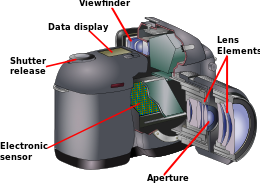
Basic elements of a modern digital single-lens reflex (SLR) still camera
Most cameras capture light from the visible spectrum, while specialized cameras capture other portions of the electromagnetic spectrum, such equally infrared.[2] : 7
All cameras use the same basic pattern: light enters an enclosed box through a converging or convex lens and an image is recorded on a low-cal-sensitive medium.[3] A shutter mechanism controls the length of time that low-cal enters the photographic camera.[iv] : 1182–1183
Most cameras also have a viewfinder, which shows the scene to be recorded, along with means to accommodate various combinations of focus, discontinuity and shutter speed.[5] : iv
Exposure command [edit]
Aperture [edit]
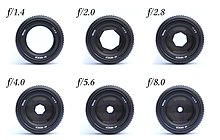
Different apertures of a lens
Lite enters a photographic camera through the aperture, an opening adjusted past overlapping plates called the aperture ring.[6] [7] [8] Typically located in the lens,[9] this opening can be widened or narrowed to alter the amount of lite that strikes the picture or sensor.[vi] The size of the aperture can exist set manually, by rotating the lens or adjusting a punch, or automatically based on readings from an internal calorie-free meter.[6]
As the aperture is adapted, the opening expands and contracts in increments called f-stops.[a] [6] The smaller the f-finish, the more calorie-free is allowed to enter the lens, increasing the exposure. Typically, f-stops range from f/1.four to f/32[b] in standard increments: ane.4, 2, ii.8, iv, 5.vi, viii, eleven, sixteen, 22, and 32.[x] The lite entering the camera is halved with each increasing increment.[9]
The wider opening at lower f-stops narrows the range of focus then the background is blurry while the foreground is in focus. This depth of field increases as the aperture closes. A narrow discontinuity results in a loftier depth of field, meaning that objects at many different distances from the camera will appear to be in focus.[11] What is acceptably in focus is determined by the circle of defoliation, the photographic technique, the equipment in use and the degree of magnification expected of the concluding epitome.[12]
Shutter [edit]
The shutter, along with the discontinuity, is 1 of 2 means to control the corporeality of light entering the camera. The shutter determines the duration that the light-sensitive surface is exposed to calorie-free. The shutter opens, calorie-free enters the camera and exposes the moving picture or sensor to light, and then the shutter closes.[9] [xiii]
There are 2 types of mechanical shutters: the leaf-type shutter and the focal-plane shutter. The leaf-blazon uses a circular iris diaphragm maintained under bound tension within or but behind the lens that quickly opens and closes when the shutter is released.[ten]

A focal-plane shutter. In this shutter, the metal shutter blades travel vertically.
More than commonly, a focal-plane shutter is used.[9] This shutter operates close to the moving picture airplane and employs metal plates or cloth curtains with an opening that passes beyond the light-sensitive surface. The curtains or plates have an opening that is pulled beyond the film plane during exposure. The focal-plane shutter is typically used in single-lens reflex (SLR) cameras, since covering the film (rather than blocking the light passing through the lens) allows the photographer to view the paradigm through the lens at all times, except during the exposure itself. Covering the film also facilitates removing the lens from a loaded camera, as many SLRs accept interchangeable lenses.[6] [x]
A digital photographic camera may utilise a mechanical or electronic shutter, the latter of which is common in smartphone cameras. Electronic shutters either record data from the entire sensor at the same time (a global shutter) or record the information line by line across the sensor (a rolling shutter).[half dozen] In flick cameras, a rotary shutter opens and closes in sync with the advancement of each frame of film.[six] [xiv]
The duration for which the shutter is open is called the shutter speed or exposure time. Typical exposure times tin can range from one second to ane/one,000 of a 2nd, though longer and shorter durations are not uncommon. In the early stages of photography, exposures were often several minutes long. These long exposure times often resulted in blurry images, as a single object is recorded in multiple places across a single paradigm for the duration of the exposure. To preclude this, shorter exposure times can be used. Very short exposure times can capture fast-moving activity and eliminate motion blur.[xv] [10] [6] [9] Even so, shorter exposure times crave more light to produce a properly exposed epitome, and so shortening the exposure fourth dimension is not always possible.
Like aperture settings, exposure times increment in powers of two. The ii settings determine the exposure value (EV), a measure out of how much calorie-free is recorded during the exposure. In that location is a direct relationship between the exposure times and discontinuity settings so that if the exposure time is lengthened one step, just the discontinuity opening is also narrowed one stride, and then the amount of light that contacts the film or sensor is the aforementioned.[9]
Metering [edit]

A handheld digital light meter showing an exposure of one/200th at an aperture of f/11, at ISO 100. The light sensor is on acme, nether the white diffusing hemisphere.
In almost modern cameras, the amount of light entering the camera is measured using a built-in lite meter or exposure meter.[c] Taken through the lens (called TTL metering), these readings are taken using a console of light-sensitive semiconductors.[vii] They are used to calculate optimal exposure settings. These settings are typically determined automatically as the reading is used by the camera's microprocessor. The reading from the light meter is incorporated with discontinuity settings, exposure times, and motion picture or sensor sensitivity to summate the optimal exposure. [d]
Lite meters typically average the light in a scene to eighteen% middle grey. More advanced cameras are more nuanced in their metering—weighing the center of the frame more heavily (center-weighted metering), considering the differences in light across the prototype (matrix metering), or allowing the photographer to have a light reading at a specific point inside the image (spot metering).[eleven] [15] [16] [6]
Lens [edit]
The lens of a camera captures light from the bailiwick and focuses it on the sensor. The pattern and manufacturing of the lens are disquisitional to photograph quality. A technological revolution in camera design during the 19th century modernized optical glass manufacturing and lens pattern. This contributed to the modern manufacturing processes of a wide range of optical instruments such every bit reading glasses and microscopes. Pioneering companies include Zeiss and Leitz.
Camera lenses are made in a wide range of focal lengths, such as extreme broad bending, standard, and medium telephoto. Lenses either have a stock-still focal length (prime number lens) or a variable focal length (zoom lens). Each lens is all-time suited to certain types of photography. Extreme broad angles might be preferred for architecture due to their ability to capture a broad view of buildings. Standard lenses commonly have a wide aperture, and considering of this, they are often used for street and documentary photography. The telephoto lens is useful in sports and wild fauna but is more than susceptible to camera milkshake, which might cause movement blur.[17]
Focus [edit]

The distance range in which objects announced clear and sharp, chosen depth of field, tin be adjusted by many cameras. This allows for a photographer to control which objects appear in focus, and which practise not.
Due to the optical properties of a photographic lens, only objects within a limited range of distance from the camera will be reproduced clearly. The process of adjusting this range is known every bit changing the photographic camera's focus. At that place are diverse means to accurately focus a photographic camera. The simplest cameras take stock-still focus and utilize a small aperture and broad-angle lens to ensure that everything within a certain range of distance from the lens, usually around three meters (10 ft.) to infinity, is in reasonable focus. Fixed focus cameras are unremarkably inexpensive, such every bit unmarried-apply cameras. The photographic camera can also take a limited focusing range or scale-focus that is indicated on the camera body. The user will guess or summate the distance to the subject field and adjust the focus accordingly. On some cameras, this is indicated by symbols (head-and-shoulders; two people standing upright; one tree; mountains).
Rangefinder cameras let the distance to objects to be measured employing a coupled parallax unit on top of the camera, allowing the focus to be prepare with accuracy. Single-lens reflex cameras allow the photographer to determine the focus and composition visually using the objective lens and a moving mirror to project the prototype onto a ground glass or plastic micro-prism screen. Twin-lens reflex cameras employ an objective lens and a focusing lens unit (usually identical to the objective lens) in a parallel torso for composition and focus. View cameras use a ground glass screen which is removed and replaced by either a photographic plate or a reusable holder containing sheet movie before exposure. Modern cameras oft offer autofocus systems to focus the camera automatically by a variety of methods.[18]
Experimental cameras such as the planar Fourier capture array (PFCA) do non crave focusing to take pictures. In conventional digital photography, lenses or mirrors map all of the light originating from a single point of an in-focus object to a single point at the sensor aeroplane. Each pixel thus relates an independent slice of information about the far-away scene. In contrast, a PFCA does not take a lens or mirror, but each pixel has an idiosyncratic pair of diffraction gratings above information technology, allowing each pixel to likewise relate an independent piece of data (specifically, one component of the 2D Fourier transform) nearly the far-away scene. Together, complete scene information is captured, and images can exist reconstructed past computation.
Some cameras support post-focusing. Postal service focusing refers to taking photos that are later focused on a computer. The photographic camera uses many tiny lenses on the sensor to capture light from every camera angle of a scene, which is known as plenoptic technology. A electric current plenoptic camera design has forty,000 lenses working together to grab the optimal moving-picture show.[nineteen]
Image capture on film [edit]
Traditional cameras capture light onto photographic plates, or photographic movie. Video and digital cameras utilise an electronic image sensor, normally a charge-coupled device (CCD) or a CMOS sensor to capture images which tin be transferred or stored in a memory card or other storage inside the photographic camera for later playback or processing.
A wide range of film and plate formats have been used by cameras. In the early history plate sizes were often specific for the make and model of cameras although at that place speedily developed some standardization for the more than popular cameras. The introduction of curlicue film drove the standardization procedure still further so that by the 1950s only a few standard coil films were in utilize. These included 120 films providing 8, 12 or 16 exposures, 220 films providing sixteen or 24 exposures, 127 films providing eight or 12 exposures (principally in Credibility cameras) and 135 (35mm film) providing 12, twenty or 36 exposures – or up to 72 exposures in the one-half-frame format or majority cassettes for the Leica Camera range.
For cine cameras, film 35mm wide and perforated with sprocket holes was established as the standard format in the 1890s. It was used for near all picture-based professional motion picture production. For apprentice use, several smaller and therefore less expensive formats were introduced. 17.5mm picture show, created by splitting 35mm picture show, was one early amateur format, but 9.5mm film, introduced in Europe in 1922, and 16 mm film, introduced in the US in 1923, shortly became the standards for "home movies" in their respective hemispheres. In 1932, the fifty-fifty more economic 8mm format was created by doubling the number of perforations in 16mm film, then splitting information technology, usually after exposure and processing. The Super viii format, still 8mm wide but with smaller perforations to make room for substantially larger flick frames, was introduced in 1965.
Film speed (ISO) [edit]
Traditionally used to tell the camera the picture show speed of the selected picture show on motion picture cameras, film speed numbers are employed on modernistic digital cameras as an indication of the system'due south gain from light to numerical output and to control the automatic exposure system. Picture show speed is normally measured via the ISO 5800 system. The higher the film speed number, the greater the picture show sensitivity to light, whereas with a lower number, the film is less sensitive to low-cal.[20]
White balance [edit]
In digital cameras, there is electronic compensation for the color temperature associated with a given set of lighting weather condition, ensuring that white calorie-free is registered equally such on the imaging chip and therefore that the colors in the frame volition appear natural. On mechanical, film-based cameras, this function is served by the operator'south pick of film stock or with color correction filters. In addition to using white rest to register the natural coloration of the prototype, photographers may utilize white balance to aesthetic terminate—for case, white balancing to a blue object to obtain a warm color temperature.[21]
Photographic camera accessories [edit]
Flash [edit]
A flash provides a short flare-up of bright light during exposure and is a commonly used artificial low-cal source in photography. Most modern wink systems use a battery-powered high-voltage discharge through a gas-filled tube to generate brilliant light for a very short fourth dimension (ane/1,000 of a second or less).[e] [sixteen]
Many flash units measure the lite reflected from the flash to help determine the appropriate duration of the wink. When the flash is attached directly to the photographic camera—typically in a slot at the elevation of the photographic camera (the flash shoe or hot shoe) or through a cable—activating the shutter on the camera triggers the flash, and the camera's internal lite meter can aid determine the elapsing of the flash.[16] [11]
Boosted wink equipment can include a light diffuser, mountain and stand, reflector, soft box, trigger and cord.
Other accessories [edit]
Accessories for cameras are mainly used for care, protection, special effects, and functions.
- Lens hood: used on the end of a lens to cake the sun or other light source to forestall glare and lens flare (run across also matte box).
- Lens cap: covers and protects the camera lens when non in use.
- Lens adapter: allows the apply of lenses other than those for which the camera was designed.
- Filter: allows artificial colors or changes light density.
- Lens extension tube: allows close focus in macro photography.
- Intendance and protection: include camera case and cover, maintenance tools, and screen protector.
- Camera monitor: provides an off-photographic camera view of the composition with a brighter and more colorful screen, and typically exposes more advanced tools such as framing guides, focus peaking, zebra stripes, waveform monitors (ofttimes as an "RGB parade"), vectorscopes and false color to highlight areas of the image critical to the photographer.
- Tripod: primarily used for keeping the camera steady while recording video, doing a long exposure, and time-lapse photography.
- Microscope adapter: used to connect a camera to a microscope to photograph what the microscope is examining.
- Cable release: used to remotely control the shutter using a remote shutter button that can be continued to the camera via a cablevision. It tin can exist used to lock the shutter open for the desired period, and it is also unremarkably used to prevent photographic camera milk shake from pressing the built-in camera shutter button.
- Dew shield: prevents moisture build-up on the lens.
- UV filter: can protect the front end element of a lens from scratches, cracks, smudges, dirt, dust, and wet while keeping a minimum impact on prototype quality.
- Battery and sometimes a charger.
Large format cameras employ special equipment that includes magnifier loupe, viewfinder, angle finder, and focusing rail/truck. Some professional SLRs tin be provided with interchangeable finders for eye-level or waist-level focusing, focusing screens, eyecup, data backs, motor-drives for motion-picture show transportation or external battery packs.
Primary types [edit]
Single-lens reflex (SLR) photographic camera [edit]
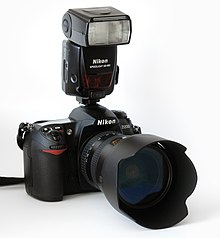
Nikon D200 digital camera
In photography, the single-lens reflex camera (SLR) is provided with a mirror to redirect light from the lens to the viewfinder prior to releasing the shutter for composing and focusing an image. When the shutter is released, the mirror swings upwards and away, allowing the exposure of the photographic medium, and instantly returns after the exposure is finished. No SLR camera before 1954 had this feature, although the mirror on some early SLR cameras was entirely operated by the forcefulness exerted on the shutter release and but returned when the finger pressure was released.[22] [23] The Asahiflex II, released by Japanese company Asahi (Pentax) in 1954, was the world'south first SLR camera with an instant return mirror.[24]
In the unmarried-lens reflex camera, the lensman sees the scene through the camera lens. This avoids the trouble of parallax which occurs when the viewfinder or viewing lens is separated from the taking lens. Single-lens reflex cameras take been fabricated in several formats including sheet movie 5x7" and 4x5", roll pic 220/120 taking eight,10, 12, or xvi photographs on a 120 roll, and twice that number of a 220 film. These correspond to 6x9, 6x7, 6x6, and 6x4.5 respectively (all dimensions in cm). Notable manufacturers of large format and roll motion picture SLR cameras include Bronica, Graflex, Hasselblad, Mamiya, and Pentax. Nonetheless, the most common format of SLR cameras has been 35 mm and later the migration to digital SLR cameras, using near identical sized bodies and sometimes using the same lens systems.
Virtually all SLR cameras utilize a front-surfaced mirror in the optical path to direct the light from the lens via a viewing screen and pentaprism to the eyepiece. At the time of exposure, the mirror is flipped upward out of the low-cal path before the shutter opens. Some early cameras experimented with other methods of providing through-the-lens viewing, including the use of a semi-transparent pellicle equally in the Canon Pellix [25] and others with a small periscope such as in the Corfield Periflex series.[26]
Big-format photographic camera [edit]
The big-format photographic camera, taking sheet motion picture, is a directly successor of the early plate cameras and remained in use for high-quality photography and technical, architectural, and industrial photography. There are iii common types: the view photographic camera, with its monorail and field camera variants, and the press camera. They have extensible bellows with the lens and shutter mounted on a lens plate at the forepart. Backs taking roll motion picture and subsequently digital backs are available in addition to the standard dark slide back. These cameras take a wide range of movements allowing very close command of focus and perspective. Limerick and focusing are done on view cameras by viewing a footing-glass screen which is replaced by the film to make the exposure; they are suitable for static subjects only and are slow to use.
Plate camera [edit]

19th-century studio camera with bellows for focusing
The earliest cameras produced in significant numbers were plate cameras, using sensitized glass plates. Light entered a lens mounted on a lens lath which was separated from the plate by extendible bellows. In that location were elementary box cameras for glass plates merely as well single-lens reflex cameras with interchangeable lenses and even for color photography (Autochrome Lumière). Many of these cameras had controls to heighten, lower, and tilt the lens forwards or backward to control perspective.
Focusing of these plate cameras was by the employ of a ground glass screen at the indicate of focus. Because lens design only allowed rather pocket-size aperture lenses, the paradigm on the ground glass screen was faint and most Photographers had a dark material to cover their heads to allow focusing and composition to be carried out more than easily. When focus and composition were satisfactory, the ground glass screen was removed, and a sensitized plate was put in its place protected by a dark slide. To make the exposure, the dark slide was carefully slid out and the shutter opened, and then closed and the dark slide replaced.
Glass plates were subsequently replaced past sheet movie in a dark slide for sheet movie; adapter sleeves were made to allow sheet film to exist used in plate holders. In add-on to the footing glass, a simple optical viewfinder was often fitted.
Medium-format camera [edit]
Medium-format cameras take a film size between the big-format cameras and smaller 35 mm cameras.[27] Typically these systems use 120 or 220 coil moving picture.[28] The most common image sizes are 6×4.5 cm, 6×6 cm and half dozen×7 cm; the older half dozen×9 cm is rarely used. The designs of this kind of camera prove greater variation than their larger brethren, ranging from monorail systems through the classic Hasselblad model with split up backs, to smaller rangefinder cameras. There are even compact amateur cameras bachelor in this format.
Twin-lens reflex camera [edit]

Twin-lens reflex cameras used a pair of about identical lenses: one to grade the image and one every bit a viewfinder.[29] The lenses were arranged with the viewing lens immediately above the taking lens. The viewing lens projects an image onto a viewing screen which can be seen from above. Some manufacturers such as Mamiya also provided a reflex head to attach to the viewing screen to allow the camera to be held to the centre when in employ. The advantage of a TLR was that it could be easily focused using the viewing screen and that under most circumstances the view seen in the viewing screen was identical to that recorded on film. At close distances, nonetheless, parallax errors were encountered, and some cameras also included an indicator to show what part of the composition would be excluded.
Some TLRs had interchangeable lenses, only every bit these had to be paired lenses, they were relatively heavy and did non provide the range of focal lengths that the SLR could support. Almost TLRs used 120 or 220 films; some used the smaller 127 films.
Meaty cameras [edit]
Instant camera [edit]
Afterward exposure, every photograph is taken through pinch rollers inside of the instant camera. Thereby the programmer paste contained in the paper 'sandwich' is distributed on the image. Later on a minute, the embrace sheet just needs to be removed and one gets a single original positive image with a stock-still format. With some systems, it was also possible to create an instant image negative, from which then could be fabricated copies in the photo lab. The ultimate development was the SX-lxx organization of Polaroid, in which a row of 10 shots – engine driven – could be made without having to remove whatever cover sheets from the film. In that location were instant cameras for a diversity of formats, likewise equally adapters for instant film use in medium- and large-format cameras.
Subminiature photographic camera [edit]
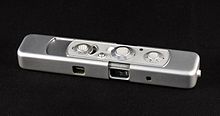
Subminiature cameras were starting time produced in the nineteenth century and use pic significantly smaller than 35mm. The expensive 8×11mm Minox, the only type of camera produced by the company from 1937 to 1976, became very widely known and was often used for espionage (the Minox company later also produced larger cameras). Later inexpensive subminiatures were made for general employ, some using rewound 16 mm cine flick. Epitome quality with these small film sizes was limited.
Folding camera [edit]
The introduction of films enabled the existing designs for plate cameras to be made much smaller and for the baseplate to exist hinged so that it could be folded up, compressing the bellows. These designs were very compact and small models were dubbed vest pocket cameras. Folding roll film cameras were preceded past folding plate cameras, more meaty than other designs.
Box camera [edit]

Box cameras were introduced as budget-level cameras and had few, if whatsoever controls. The original box Credibility models had a small reflex viewfinder mounted on the top of the camera and had no aperture or focusing controls and just a simple shutter. Later models such as the Brownie 127 had larger direct view optical viewfinders together with a curved film path to reduce the touch of deficiencies in the lens.
Rangefinder camera [edit]

Rangefinder photographic camera, Leica c. 1936
Every bit photographic camera lens engineering science developed and broad aperture lenses became more than common, rangefinder cameras were introduced to brand focusing more precise. Early rangefinders had two separate viewfinder windows, 1 of which is linked to the focusing mechanisms and moved right or left as the focusing band is turned. The two split up images are brought together on a footing glass viewing screen. When vertical lines in the object being photographed meet exactly in the combined image, the object is in focus. A normal composition viewfinder is also provided. Subsequently the viewfinder and rangefinder were combined. Many rangefinder cameras had interchangeable lenses, each lens requiring its range- and viewfinder linkages.
Rangefinder cameras were produced in half- and total-frame 35 mm and roll film (medium format).
Move flick cameras [edit]
A picture show camera or a video camera operates similarly to a still camera, except it records a serial of static images in rapid succession, commonly at a rate of 24 frames per 2d. When the images are combined and displayed in society, the illusion of motion is achieved.[xxx] : 4
Cameras that capture many images in sequence are known as moving picture cameras or every bit cine cameras in Europe; those designed for single images are still cameras. However, these categories overlap every bit still cameras are oft used to capture moving images in special effects work and many modern cameras can quickly switch between still and motion recording modes.
A ciné photographic camera or picture camera takes a rapid sequence of photographs on an paradigm sensor or strips of film. In contrast to a still camera, which captures a single snapshot at a time, the ciné camera takes a serial of images, each chosen a frame, through the utilize of an intermittent mechanism.
The frames are later on played dorsum in a ciné projector at a specific speed, called the frame rate (number of frames per second). While viewing, a person'southward optics and brain merge the separate pictures to create the illusion of movement. The first ciné camera was congenital around 1888 and past 1890 several types were being manufactured. The standard film size for ciné cameras was chop-chop established as 35mm film and this remained in utilize until the transition to digital cinematography. Other professional standard formats include 70 mm film and sixteen mm moving-picture show whilst amateur filmmakers used nine.five mm film, eight mm film, or Standard 8 and Super viii earlier the motility into digital format.
The size and complexity of ciné cameras vary greatly depending on the uses required of the camera. Some professional equipment is very large and likewise heavy to be handheld whilst some amateur cameras were designed to be very small and light for single-handed performance.
Professional video camera [edit]

A professional video camera (often called a television camera even though the employ has spread beyond television) is a high-stop device for creating electronic moving images (as opposed to a movie camera, that earlier recorded the images on film). Originally developed for use in goggle box studios, they are now likewise used for music videos, direct-to-video movies, corporate and educational videos, matrimony videos, etc.
These cameras earlier used vacuum tubes and subsequently electronic image sensors.
Camcorders [edit]
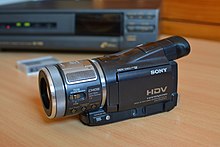
Sony HDR-HC1E, a HDV camcorder.
A camcorder is an electronic device combining a video photographic camera and a video recorder. Although marketing materials may use the colloquial term "camcorder", the name on the packet and manual is oft "video photographic camera recorder". Well-nigh devices capable of recording video are camera phones and digital cameras primarily intended for all the same pictures; the term "camcorder" is used to draw a portable, self-contained device, with video capture and recording its primary function.
Digital camera [edit]
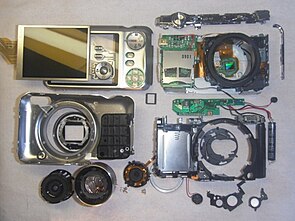
Disassembled Digital Photographic camera
A digital photographic camera (or digicam) is a photographic camera that encodes digital images and videos and stores them for later reproduction.[31] They typically use semiconductor image sensors.[32] Most cameras sold today are digital,[33] and they are incorporated into many devices ranging from mobile phones (called photographic camera phones) to vehicles.
Digital and picture cameras share an optical system, typically using a lens of variable aperture to focus light onto an prototype pickup device.[34] The discontinuity and shutter admit the correct amount of low-cal to the imager, just as with film but the image pickup device is electronic rather than chemical. Yet, dissimilar film cameras, digital cameras tin display images on a screen immediately later on being captured or recorded, and store and delete images from retention. Almost digital cameras can also record moving videos with sound. Some digital cameras can ingather and sew together pictures & perform other elementary prototype editing.
Consumers adopted digital cameras in the 1990s. Professional person video cameras transitioned to digital around the 2000s–2010s. Finally, picture show cameras transitioned to digital in the 2010s.
The first camera using digital electronics to capture and store images was developed by Kodak engineer Steven Sasson in 1975. He used a charge-coupled device (CCD) provided past Fairchild Semiconductor, which provided only 0.01 megapixels to capture images. Sasson combined the CCD device with movie camera parts to create a digital camera that saved black and white images onto a cassette tape.[35] : 442 The images were then read from the cassette and viewed on a Television set monitor.[36] : 225 Later, cassette tapes were replaced by wink memory.
In 1986, Japanese visitor Nikon introduced an analog-recording electronic single-lens reflex camera, the Nikon SVC.[37]
The get-go full-frame digital SLR cameras were adult in Nippon from around 2000 to 2002: the MZ-D by Pentax,[38] the N Digital by Contax's Japanese R6D squad,[39] and the EOS-1Ds by Canon.[40] Gradually in the 2000s, the full-frame DSLR became the ascendant camera blazon for professional photography.[ citation needed ]
On most digital cameras a display, often a liquid crystal display (LCD), permits the user to view the scene to be recorded and settings such equally ISO speed, exposure, and shutter speed.[five] : 6–seven [41] : 12
Camera phone [edit]

Smartphone with congenital-in camera
In 2000, Abrupt introduced the globe'due south kickoff digital camera phone, the J-SH04 J-Phone, in Japan.[42] Past the mid-2000s, college-end prison cell phones had an integrated digital photographic camera, and by the offset of the 2010s, almost all smartphones had an integrated digital camera.
Run into also [edit]
- Photographic camera matrix
- History of the camera
- Cameras in mobile phones
- List of photographic camera types
- Timeline of historic inventions
Footnotes [edit]
- ^ These f-stops are also referred to as f-numbers, stop numbers, or simply steps or stops. Technically the f-number is the focal length of the lens divided by the bore of the effective aperture.
- ^ Theoretically, they can extend to f/64 or higher.[8]
- ^ Some photographers use handheld exposure meters independent of the camera and use the readings to manually set up the exposure settings on the photographic camera.[16]
- ^ Film canisters typically contain a DX code that can be read by modern cameras so that the photographic camera's computer knows the sensitivity of the film, the ISO.[9]]
- ^ The older type of disposable flashbulb uses an aluminum or zirconium wire in a drinking glass tube filled with oxygen. During the exposure, the wire is burned away, producing a bright flash.[sixteen]
References [edit]
- ^ "World'southward oldest photograph sold to library". BBC News. 21 March 2002. Retrieved 17 Nov 2011.
The image of an engraving depicting a man leading a horse was made in 1825 by Nicéphore Niépce, who invented a technique known as heliogravure.
- ^ Gustavson, Todd (2009). Photographic camera: a history of photography from daguerreotype to digital. New York: Sterling Publishing Co., Inc. ISBN978-i-4027-5656-6.
- ^ "camera design | designboom.com". designboom | compages & pattern magazine . Retrieved 18 September 2021.
- ^ Immature, Hugh D.; Freedman, Roger A.; Ford, A. Lewis (2008). Sears and Zemansky's University Physics (12 ed.). San Francisco, California: Pearson Addison-Wesley. ISBN978-0-321-50147-9.
- ^ a b London, Barbara; Upton, John; Kobré, Kenneth; Brill, Betsy (2002). Photography (vii ed.). Upper Saddle River, New Jersey: Prentice Hall. ISBN978-0-thirteen-028271-ii.
- ^ a b c d eastward f 1000 h i Columbia Academy (2018). "camera". In Paul Lagasse (ed.). The Columbia Encyclopedia (8 ed.). Columbia University Press.
- ^ a b "How Cameras Work". How Stuff Works. 21 March 2001. Retrieved thirteen December 2019.
- ^ a b Laney, Dawn A. ..BA, MS, CGC, CCRC. "Camera Technologies." Salem Press Encyclopedia of Science, June 2020. Accessed 6 February 2022.
- ^ a b c d e f g Lynne Warren, ed. (2006). "Camera: An Overview". Encyclopedia of twentieth-century photography. New York: Routledge. ISBN978-1-57958-393-4.
- ^ a b c d "engineering of photography". Britannica Academic . Retrieved 13 December 2019.
- ^ a b c Lynne Warren, ed. (2006). "Camera: 35 mm". Encyclopedia of twentieth-century photography. New York: Routledge. ISBN978-1-57958-393-4.
- ^ The British Journal Photographic Almanac. Henry Greenwood and Co. Ltd. 1956. pp. 468–471.
- ^ Rose, B (2007). "The Camera Defined". The Focal Encyclopedia of Photography. Elsevier. pp. 770–771. doi:10.1016/B978-0-240-80740-nine.50152-v. ISBN978-0-240-80740-ix . Retrieved 12 Dec 2019.
- ^ "Movement-motion-picture show camera". Encyclopedia Britannica . Retrieved 12 December 2019.
- ^ a b "Camera". World Encyclopedia. Philip's. 2004. ISBN978-0-19-954609-1 . Retrieved 12 December 2019.
- ^ a b c d e "camera". Britannica Academic . Retrieved 12 December 2019.
- ^ McHugh, Sean. "Understanding Camera Lenses". Cambridge in Color. Archived from the original on 19 August 2013.
- ^ Chocolate-brown, Gary (Apr 2000). "How Autofocus Cameras Work". HowStuffWorks.com. Archived from the original on 30 September 2013.
- ^ Wehner, Mike (xix Oct 2011). "Lytro photographic camera lets you focus after shooting, now available for pre-lodge". Yahoo! News. Archived from the original on 22 October 2011.
- ^ "How important is motion-picture show speed?". HowStuffWorks. seven December 2010. Retrieved 21 September 2021.
- ^ "Agreement White Balance". www.cambridgeincolour.com . Retrieved 21 September 2021.
- ^ Roger Hicks (1984). A History of the 35 mm Still Camera. Focal Press, London & Boston. p. 137. ISBN978-0-240-51233-four.
- ^ Rudolph Lea (1993). Annals of 35 mm SLR cameras. Wittig Books, Hückelhoven. p. 23. ISBN978-3-88984-130-8.
- ^ Michael R. Peres (2013), The Focal Encyclopedia of Photography, p. 779, Taylor & Francis
- ^ "Canon Pellix Camera". Photography in Malaysia. Archived from the original on sixteen October 2013.
- ^ Parker, Bev. "Corfield Cameras – The Periflex Era". Wolverhampton Museum of Industry.
- ^ Wildi, Ernst (2001). The medium format reward (2nd ed.). Boston: Focal Press. ISBN978-1-4294-8344-five. OCLC 499049825.
- ^ The manual of photography. Elizabeth Allen, Sophie Triantaphillidou (tenth ed.). Oxford: Elsevier/Focal Printing. 2011. ISBN978-0-240-52037-7. OCLC 706802878.
{{cite book}}: CS1 maint: others (link) - ^ Burrows, Paul (13 September 2021). "The rise and fall of the TLR: why the twin-lens reflex camera is a real classic". Digital Photographic camera World. Future Us Inc. Retrieved 27 December 2021.
- ^ Ascher, Steven; Pincus, Edward (2007). The Filmmaker'southward Handbook: A Comprehensive Guide for the Digital Age (3 ed.). New York: Penguin Grouping. ISBN978-0-452-28678-8.
- ^ Farlex Inc: definition of digital camera at the Free Dictionary; retrieved 7 September 2013
- ^ Williams, J. B. (2017). The Electronics Revolution: Inventing the Future. Springer. pp. 245–8. ISBN978-iii-319-49088-5.
- ^ Musgrove, Mike (12 January 2006). "Nikon Says It'south Leaving Pic-Camera Business organisation". Washington Mail . Retrieved 23 Feb 2007.
- ^ MakeUseOf: How does a Digital Camera Piece of work; retrieved 7 September 2013
- ^ Gustavson, Todd (1 November 2011). 500 Cameras: 170 Years of Photographic Innovation. Toronto, Ontario: Sterling Publishing, Inc. ISBN978-1-4027-8086-8.
- ^ Hitchcock, Susan (editor) (xx September 2011). Susan Tyler Hitchcock (ed.). National Geographic consummate photography. Washington, D.C.: National Geographic Gild. ISBN978-1-4351-3968-viii.
- ^ Nikon SLR-type digital cameras, Pierre Jarleton
- ^ The long, difficult road to Pentax full-frame The long, hard road to Pentax total-frame, Digital Photography Review
- ^ British Journal of Photography, Problems 7410-7422, 2003, p. 2
- ^ Canon EOS-1Ds, 11 megapixel full-frame CMOS, Digital Photography Review
- ^ Burian, Peter; Caputo, Robert (2003). National Geographic photography field guide (2 ed.). Washington, D.C.: National Geographic Social club. ISBN978-0-7922-5676-ii.
- ^ "Evolution of the Camera phone: From Sharp J-SH04 to Nokia 808 Pureview". Hoista.net. 28 February 2012. Retrieved 21 June 2013.
Further reading [edit]
- Ascher, Steven; Pincus, Edward (2007). The Filmmaker's Handbook: A Comprehensive Guide for the Digital Historic period (three ed.). New York: Penguin Group. ISBN978-0-452-28678-8.
- Frizot, Michel (Jan 1998). "Light machines: On the threshold of invention". In Michel Frizot (ed.). A New History of Photography. Koln, Germany: Konemann. ISBN978-3-8290-1328-four.
- Gernsheim, Helmut (1986). A Concise History of Photography (iii ed.). Mineola, New York: Dover Publications, Inc. ISBN978-0-486-25128-8.
- Hirsch, Robert (2000). Seizing the Light: A History of Photography. New York: McGraw-Hill Companies, Inc. ISBN978-0-697-14361-7.
- Hitchcock, Susan (editor) (xx September 2011). Susan Tyler Hitchcock (ed.). National Geographic complete photography. Washington, D.C.: National Geographic Guild. ISBN978-1-4351-3968-8.
- Johnson, William Southward.; Rice, Mark; Williams, Carla (2005). Therese Mulligan; David Wooters (eds.). A History of Photography. Los Angeles, California: Taschen America. ISBN978-3-8228-4777-0.
- Spira, S.F.; Lothrop, Jr., Easton S.; Spira, Jonathan B. (2001). The History of Photography as Seen Through the Spira Collection. New York: Aperture. ISBN978-0-89381-953-8.
- Starl, Timm (January 1998). "A New Globe of Pictures: The Daguerreotype". In Michel Frizot (ed.). A New History of Photography. Koln, Frg: Konemann. ISBN978-three-8290-1328-four.
- Wenczel, Norma (2007). "Part I – Introducing an Instrument" (PDF). In Wolfgang Lefèvre (ed.). The Optical Camera Obscura Ii Images and Texts. Inside the Camera Obscura – Optics and Art under the Spell of the Projected Image. Max Planck Institute for the History of Science. pp. 13–30. Archived from the original (PDF) on 2 April 2012.
External links [edit]
| | Wikimedia Commons has media related to Photographic camera. |
- How cameras works at How stuff works.
Source: https://en.wikipedia.org/wiki/Camera
Posted by: craighatiagoorah.blogspot.com

0 Response to "What Does On A Camera Mean"
Post a Comment